
Setup & config options
Suitable power supply
RasPi & sFTP file transfer
Home network print server
Home network scan server
Mesh : home Lan USB drive
Explore hard & software
UFW firewall explained
Secured by fail2ban server
Software packaging & PPA
Apache 2.4+ LAMP server
https web server : port 443
Varnish caching proxy
Module : cgi & perl
Module : geoip
Modules : php & mysql
http*s error handling
Server : conditional logging
TL-domain & dynamic DNS
Webalizer log analyser
Defeat referrer spam
robots.txt & xml sitemaps
Server : .htaccess handling
The game & not the islands
Setup & config options
North Atlantic : Macaronésia
🚫 No ads & tracking
Macao - portuguese: Macau
Macao special administrative region of the People's Republic of China
The ample information about Macao (Macau)
This is an older article which I wrote on a free subdomain provided by Wordpress many years ago.
11-Dec 2018
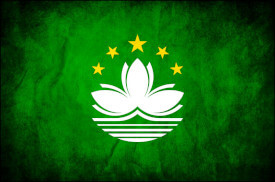
Macao overview
Macau and the Europeans : The Portuguese were the first Europeans to settle the China coast and although there were scattered communities of a few isolated individuals along the Guangdong shoreline from the early 1500s it was at Ah Ma Gao that the Portuguese established a viable community in 1557. But long before any Portuguese explorer had rounded the Cape of Good Hope, seen the Indian Ocean or found the Spice Islands, the great Chinese fleets of exploration and trade had reached as far west as Mogadishu in East Africa. The high point of Chinese maritime discovery was from 1400-1450 when fleets of up to 100 vessels and carrying 28,000 men sailed systematically to Mogadishu in East Africa, to Calicut and Goa in India and to Bantam and Moluccas in the Spice Islands. By contrast, when the Portuguese came to the Pacific they had perhaps five vessels and at most 300 men. Bartolomeu Dias rounded the Cape of Good Hope in 1487, Vasco da Gama reached Goa in 1497 and Calicut in 1498. And it took Alvares until 1513 to reach Lintin and then Canton.
Chinese maritime activity was in decline from 1450 so that the Portuguese only met Chinese navigators for the first time, not in the Persian Gulf or at Calicut, but at Malacca in the East Indies.
When the Portuguese arrived in the Indian and Pacific Oceans they found that the spice trade from Bantam through Calicut and Goa to the Red Sea and the Persian Gulf was controlled and dominated by Muslim traders carrying their cargoes of spice in dhows. Although the Portuguese were aware of the extensive knowledge of navigation that the Moors had accumulated they were surprised by the extent of their command of the trade routes of the Indian Ocean. And although Muslim navigators had played a significant role in advancing Portuguese exploration east of Africa, the Moors didn’t welcome Portuguese encroachment on their trade. Relations between them were generally fractious and often hostile.
The overview map
Macao Peninsula and the islands : Taipa, Coloane, and Cotai
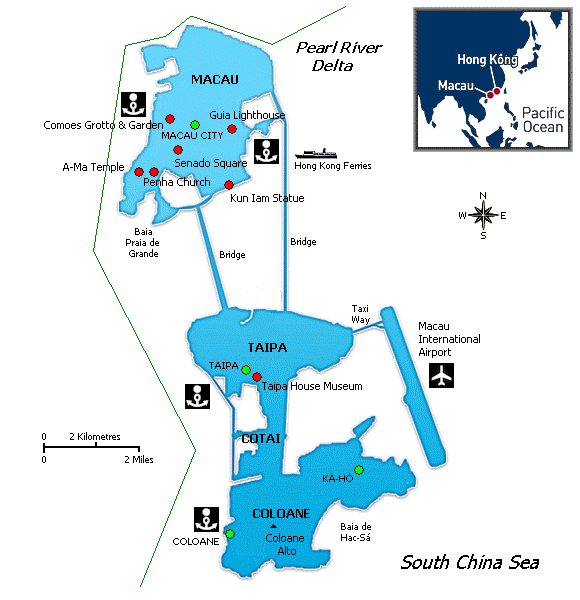
The facts on history
The Portuguese, like the Spanish, had been forced to seek an Atlantic sea route to the Spice Islands as the land routes through the Ottomans were tightly controlled in the Eastern Mediterranean by the traders of Venice and Genoa and monopolized by the Moors in the Indian Ocean.
Very few trade goods from Asia reached the Iberian Peninsula and there was no opportunity for the Portuguese or the Spanish to share in the trading profits. Under Papal authority the Portuguese claimed exploration rights to the south of Western Europe and east to the Indies. But on arriving in the Indian Ocean the Moors were equally determined to exclude the Portuguese from the profit of trade. The Portuguese response to this tightly controlled trading environment was to establish protected supply stations along the eastern coast of Africa and the western coast of India, by force. By controlling entry to the Red Sea and the Persian Gulf, Portugal was able to take monopoly control of the spice trade from the Moors. The Portuguese established settlements at Goa on the west coast of India, in Ceylon (Sri Lanka), Malacca (Malaya) and East Timor. Stories of Portuguese ferociousness in establishing trade stations and dominating their trade rivals preceded their arrival in Southern China and largely explains why the Chinese authorities refused them entry, residence or trading rights.
Meanwhile the Spanish sought a Papal bull to sovereign rights over any land they discovered as they sailed west in search of a direct route to China. Brazil fell to the Portuguese whilst Mexico and most of South America fell under Spanish influence. By the late 1500s the Spanish had colonized the Philippines, discovered the Caroline Islands in Micronesia, the Solomon Islands in Melanesia and the Marquesas Islands in Polynesia and Spanish galleons regularly left the Americas for the Philippines. Portuguese and Spanish trade rivalry would recommence, not in Europe, but in Bantam and Moluccas in the Spice Islands (Indonesia), in Formosa (Taiwan) and Japan
For pragmatic reasons the Chinese soon lifted the trade ban on the Portuguese. By 1530 Portuguese settlement was tolerated, although not encouraged, and trade flowed to mutual advantage. And by 1555 Macau had become an important centre in the trade of gold, silver, silk and porcelain between Goa, China and Japan. At this time there was an active ban on Chinese – Japanese trade but China, short of silver, badly needed access to the silver supplies available from Japan. And the Japanese were equally keen for Chinese porcelains and silks. The Portuguese became the natural middlemen to facilitate this trade impasse and to ensure its regularity took up residence at Ah Ma Gao. As the Chinese turned a blind eye to Portuguese settlement the growing centre of Macau became increasingly independent and by 1557 the Portuguese were firmly entrenched. They would build Macau into a successful entrepot for trade between China, Japan, India and Europe.
It is thought that the Portuguese name ‘Macau’ originates from an ancient seafarer’s story. According to legend a Chinese junk was caught by a storm in the South China Sea and a young woman on board drove the elements away, saving everyone. When the junk landed at Hoi Keang the woman walked to Barra Hill and then rose into the sky in a beam of light and vanished. A Tin Hau temple was built on the landing spot to honour her memory and protect all future seafarers. Known as the Ah Ma Temple, it stands in Ah Ma Gao or Ah Ma Bay. When the Portuguese settled on the China coast they transcribed the Cantonese ‘Ah Ma Gao’ as Amagau. They later shortened this to ‘Macau’. Gradually the name Macau came to refer to the entire Portuguese settlement around and beyond A-Ma Bay. In English, the Portuguese term ‘Macau’ is spelt Macau.
Macau was Chinese territory for millennia but only developed as a major settlement in the 16th century with Portuguese settlement. The Portuguese abandoned St John’s Island in 1554 for Lampacao, which was 20 miles closer to the mouth of the Pearl River, and soon after moved to Ah Ma Gao. The Portuguese not only used Macau to develop regional trade but to spread Catholicism to China and Japan. But success was slow. China restricted trade access beyond Macau and regularly prohibited the Jesuits, Dominicans, Augustinians, and Franciscans from preaching in China. None-the-less, by the mid 1700s Macau had become the main European trading post on the southern China coast; a position it held until the British took Hong Kong in 1841. Macau’s strategic trade advantage came from the Ch’ing Dynasty decision to only allow European entry to China through the Barrier Gate or Portas do Cerco on Macau’s northern boundary. The only way Europeans could enter China was through Macau. This regime lasted from 1573 until the opening of the China ports to trade following the ‘Opium Wars’ of 1840 and 1860.
Trade with Canton and Japan flourished as Portuguese and Chinese merchants flocked to Macau and the settlement quickly became the centre of Portuguese trade with India, southern China, Japan, and Southeast Asia. A walled village took shape and although China retained sovereignty over Chinese residents who were subject to Chinese law, the territory came firmly under Portuguese administration. By 1582 a land lease was signed with annual rent paid to Xiangshan County and by 1586 Macau became a self-governing city. But the islands of Taipa and Coloane weren’t incorporated into Macau until after the First Opium War with Britain in the early nineteenth century
The Portuguese had established Goa in 1510, Malacca in 1511 and by 1513 had arrived on the China coast. They landed on Lintin Island in the Pearl River estuary and claimed the island for the King of Portugal. Adventurers from Portugal arrived again at Haojingao in 1517-1518. In 1521 Chinese officials expressed their displeasure at these violations of China's sovereignty by forcibly expelling the Portuguese from the Guangdong coast. But traders still continued to call and it is commonly said that around 1553 the Portuguese bribed officials in Guangdong to allow them to anchor and trade from Macau. This was the beginning of the permanent Portuguese presence in the Pearl River Delta and the early settlements that had sprang up along the Guangdong coast gradually consolidated at Macau. In 1557 the Portuguese rented the Macau peninsula from China and once established set about developing regional trade routes. As Imperial decrees forbade Chinese leaving China, the Portuguese soon became the sole agents for mainland traders and Macau prospered.
Broadly speaking the history of Macau has three phases. The first period was the silver phase through Macau’s monopoly trade with Japan. Chinese silk was traded for Japanese silver. The second period was as the official gateway to China. This phase was enhanced through the representative of the Chinese Hoppo living in Macau. This enabled traders to arrange all customs duties and taxes as well as entry permits for China while in Macau and before they entered China. Traders from Holland, Spain, France, Italy, Germany, Britain and America all benefited from this service and Macau prospered as a supply and service centre for the China trade. The third period, post 1847, saw Macau in decline as it no longer was of any practical value to the European traders. With the loss of the Barrier Gate as the sole entry point to China, Macau lost its most valuable competitive advantage. Consequently Macau, now a free port, became a minor player in the entrepot trade and a centre for the sleezy side of gambling, which had been legalized in 1847.
But the first challenge to Portuguese supremacy came not from the British but from the Dutch. Although the Portuguese were the dominant European traders in the Indian Ocean and the Western Pacific during the 1500s the Dutch began to threaten Portuguese pre-eminence in the 1600s. In Europe, Dutch ships increasingly carried Portuguese cargo for regional distribution throughout Central and Northern Europe and the Dutch were the largest buyers of Portuguese spices and other goods from Asia. In this way Dutch captains had come to know the true value of the cargoes from the East Indies and as they had access to Portuguese maps were capable of trading directly with Asia. In 1580 Portugal united with Spain under King Philip II. As the Dutch were Philip’s enemy he prohibited their ships from entering Portuguese ports. This forced the Dutch to go east themselves. None-the-less the Spanish and Portuguese held their monopoly over the East Indies spice trade until the destruction of the Spanish Armada by Britain in 1588. This naval defeat permitted both the Dutch and the British to seek their share of the spice trade. The Portuguese residents of Goa and Malacca made several attempts to prevent the Dutch from entering East Asia but were unsuccessful and the first Dutch trading voyage returned from Bantam with a cargo of pepper in 1595. Dutch ships were superior to their Portuguese rivals and the Spice Island rulers welcomed Dutch buyers as the competition raised export prices for their spices.
Dutch merchants had founded the Vereenigde Landsche Ge-Oktroyeerde Oostindische Compagnie, better known as the Dutch East India Company, in 1602. This company, granted a monopoly over the Indies spice trade and the trade between South Africa and Japan, was empowered to erect fortifications, appoint governors, keep a standing army and conclude treaties in its own name. As early as 1601 the Dutch made their intentions clear when they destroyed a Portuguese fleet in a full-scale naval battle in the Bay of Bantam. Portuguese merchants, whose pepper purchases had been important in the growth of Bantam, abandoned the city. In 1602 Dutch ships attacked Portuguese cargoes of Japanese copper, American silver, and Chinese porcelain and silk on route to Malacca from Macau. The Dutch plundering of Portuguese carracks as they returned to Europe from Asia was followed by armed Dutch merchantmen attacking Portuguese settlements in Asia. Batavia, now known as Jakarta, soon became the headquarters of the Dutch East Indies Company’s operations throughout Asia. They attacked Manila Bay in 1618, Macau in 1622 and Gulangyu in 1623 and forcibly established Dutch rule over Formosa (Taiwan) in 1624. They attacked the Portuguese settlement of Malacca in the Malay Peninsular in 1597, 1606 and 1636 and took the city in 1641. And it was from Batavia that the Dutch challenged the Portuguese trade monopoly with Japan. Although the Dutch repeatedly attacked Portuguese settlements in East Asia the ill prepared Macanese managed to successfully defend their city against the 1622 attack and other Dutch harassments. Over time the Dutch gradually learnt that the Straits of Formosa were much more difficult to control than the Straits of Malacca and that the only effective way to increase their access to China trade was to improve their diplomatic skills in China and Japan and to reduce their reliance on unprovoked aggression and privateering.
The Portuguese traders of Macau responded to the demise of silver cargoes from the Americas, waning Spanish influence in the Philippines and the rising Dutch presence in the Pacific by restructuring their regional trade. First with Nagasaki and Manila, then, as Macau was cut off from Goa by the Dutch occupation of Malacca, with Indo-China and Timor. Finally, they carried Chinese silks directly to Mexico and Peru. But the Dutch attack on Portuguese Malacca, which began in June 1640 and saw the city fall to the Dutch in 1641, signaled the end of Portuguese pre-eminence in East Asian trade. Portuguese traders had been banned from the Philippines in 1636 due to their avarice and excessive profit taking and they met the same fate in Japan in 1639. With Malacca falling to the Dutch, Macau was cut off, not only from Goa but from the entire ‘Estado do India’ and although the Portuguese carried valuable silks to Mexico and Peru the former ‘Spanish Lake’ was increasingly dominated by Dutch and British mariners. Macau slipped quietly into an off-season residential centre for British, French, American and Danish ‘China traders’ interested only in the Canton trading season. And after two-and-a-half centuries of Portuguese occupation Macau’s harbour had silted up so that larger ships could no longer birth. Consequently, the British, who were increasingly at odds with the Chinese officials in Canton over their opium smuggling, eyed Hong Kong as the sheltered deepwater port of choice. By February 1841 a British garrison had occupied Hong Kong Island and many of the Macau based traders took this opportunity to relocate. When the great typhoon of August 1874 laid waste to Hong Kong and Macau, Hong Kong recovered economically but Macau didn’t.
The Portuguese traders who had taken Chinese silks and porcelains to the west coast of India to be exchanged for fabrics and textiles, who had taken Indian textiles to Malacca to be exchanged for sandalwood and spices for barter in Japan, and who had loaded their ships in Japan with lacquer-ware, intricate fans, swords and silver for their China markets so that they could barter these goods for still more Chinese silk and porcelain, were long gone. In another half century Englishmen began to dominate trade along the China coast and Macau became a sleepy backwater, the summer residence of the Taipans who, under Chinese law, had to leave the godowns of Canton at the end of the trading season. As Englishmen traded their opium from the protection of Colonial Hong Kong, Macau became an outpost of gambling and prostitution run by Chinese gangs. And so it remained until very shortly before its return to Chinese sovereignty in 1999.
Dutch power began to decline towards the end of the eighteenth century as British imperialist power grew. This coincided with Europe's preference for coffee over tea with a result that Continental European commercial interests were increasingly redirected towards the America’s. The Dutch East India Company was finally liquidated in 1795 and Malacca passed, by agreement, to Britain in 1824.During the 17th and 18th centuries Britain, France, Denmark, Spain, Austria, and Sweden also established merchant-companies to monopolize Asian trade. The most successful of these was the British ‘East India Company’ which, following a year of fund raising and political negotiation by the ‘Company of Merchants of London trading into the East Indies’, was given ‘royal approval’ by a charter from Queen Elizabeth I on 31 December 1600. For 100 years the Dutch East India Company out-maneuvered the British East India Company. But the tide gradually turned and although other nations participated, the British and French came to dominate Pacific exploration in the 18th century. Beginning in the mid-1700s, Britain and France began to send out rival scientific expeditions to explore and chart the islands of the Pacific. French expeditions included Louis-Antoine de Bougainville (1766–69), Jean-François de la Pérouse (1785–88), Étienne Marchand (1790–92), and Antoine-Raymond-Joseph de Bruni d’Entrecasteaux (1791–93). Samuel Wallis (1767–68) and Philip Carteret (1767–68) were well known British explorers. But the most accomplished British explorer was James Cook. He made three voyages to the Pacific in 1768–71, 1772–75, and 1776–80. By 1800 the myth of a vast southern continent had been dispelled, almost the entire Pacific basin had been charted and the Pacific region had been brought to the forefront of western consciousness.
Pepper had made Bantam rich and transformed it into one of the largest cities in Southeast Asia. So it was from Bantam on the northern coast of Java that the British East India Company established its first Asian ‘factory’ - a place where factors, or Company representatives, lived and traded. And it was from Bantam that the British were able to expand into other parts of Asia. But by 1813 the British East India Company’s monopoly of Asian trade was limited to China and by 1833 even that was abolished as advocates of Free Trade came to dominate British politics.
British clippers had started to arrive on the China coast from the early 1700s and used Macau as their supply base for 100 years. When the British Exchequer became depleted of silver, due to excessive purchases of Chinese tea, these traders began shipping opium from India to China. This brought them into direct conflict with the Chinese authorities and indirect disagreement with the Macanese who had pressure exerted on them from China. When, in 1800, opium became a prohibited import in China the British traders had to find trade stations beyond both Portuguese and Chinese jurisdiction. Under increasing pressure from the Chinese authorities over their opium imports, the British traders withdrew from Canton and Whampoa to Macau and then from Macau itself. They re-established themselves first at Lintin Island and then Hong Kong, which was finally ceded to Britain after the First Opium War of 1839-41. The 1842 Treaty of Nanking opened several ports, including Canton, to British trade and entitled British traders the right to reside along the banks of the Pearl River around the Shameen sandbank. Following the First Opium War the Portuguese took advantage of the weakened state of the Ch’ing Dynasty and seized the islands of Taipa and Coloane to the south of the Macau Peninsula and established greater Macau as we know it today. But coincidentally, this also signaled the end of Macau as a significant trading port. During the 17th, 18th, and 19th centuries Macau powered as the centre for Portuguese trade with Canton, Japan, the Philippines, Southeast Asia, Goa, Mexico and Peru. But with the opening of Canton to British traders and the cession of Hong Kong to Britain, Macau was no longer commercially viable. For although China officially established Macau as a foreign-trade port in 1865, Lisbon's decline in the mid-seventeenth century, the changing balance of European power in East Asia, events within the court of the Ch’ing Dynasty, the development of Hong Kong by the British and the opening of treaty ports along the China coast after 1842 ended Macau's status as the preferred port of call for European traders.
Although Portuguese ambitions were severely frustrated by the British after 1840 it was largely through Macau that Western mathematics, astronomy, geography, medicine, physics, architecture, linguistics, art and music were introduced to China and of course Confucian philosophy, classical Chinese literature, Chinese medicine, art, painting and architecture passed to the West through Portuguese intellectuals in Macau. But Macau descended into obscurity as quickly as it rose to prominence. Portuguese fortunes declined in Europe and the colonial ambitions of Holland and Britain changed the European balance of power in Asia. Macau's golden age came to an end in the 1630s when Japan closed to foreign trade in 1637, the Dutch took Malacca by force in 1641 and the port of Canton was closed to the Portuguese. The only solace for Macau was the introduction of licensed gambling by the Governor in 1847 as a desperate attempt to counter the sudden rise of Hong Kong as a China station in 1841. The 18th century wars such as the Wars of the Spanish and Austrian Succession, left Britain as the dominant European power in Asia, and after the French Revolutionary War and the Napoleonic Wars, Britain’s worldwide role became imperial. From this time until the early 20th century, Britain’s sea power in the Far East went increasingly unchallenged. But even Britain’s power was to decline. Contact with India began to wane after the Second World War and with the Malay Peninsula and Singapore after the late 1950s. The Chinese “Treaty Ports” were successively given up in 1949 and sovereignty over Hong Kong returned to China in 1997. Meanwhile, following the defeat of Japan and the ending of the Pacific theatre of World War Two, the United States of America became the most influential European power in Asia.
Although Portuguese for almost 500 years, Macau’s legal status has never been certain. Until 1844 Macau was administered through the jurisdiction of Portugal's Indian colonies known as "Estado Português da India". Following 1844, Macau and East Timor held the status of a Portuguese overseas province. But Peking refused to recognize this status on the basis of its unilateral declaration. Further, in 1845 Portugal declared that Macau was a free port, expelled Chinese officials and levied taxes on Chinese residents. Wanzhai Island to the north of Macau was taken in 1849 and relinquished in 1887. And in 1849 Portugal unilaterally abolished the Chinese customs house, declared that Macau was independent and terminated rent on the lease of Macau. The Chinese retaliated by assassinating Governor Ferreira do Amaral. Then in 1851 Portugal seized Taipa Island and took Coloane in 1864. Although the 1862 Treaty of Tientsin recognized Macau as a Portuguese colony, China failed to ratify this treaty with the result that Macau was never legally ceded to Portugal. Macau and East Timor were again combined as an overseas province of Portugal in 1883, but this time under the control of Goa. In 1887 a protocol ‘respecting relations between Portugal and China’ was signed in Lisbon. This protocol confirmed that the ‘perpetual occupation and government of Macau’ was Portuguese and under the agreement Portugal promised not to alienate Macau without prior agreement with Peking. But although Taipa and Coloane were ceded to Portugal the border with the mainland was never legally established. Then in 1888 came the Treaty of Commerce and Friendship. This recognized Portuguese sovereignty over Macau but was also never ratified by China. Then the Ilha Verde was incorporated into Macau's territory in 1890. But lying just a kilometre offshore, it was absorbed into peninsula Macau through land reclamation by 1923. These and other historical events illustrate the tenuous nature of Portuguese claims to sovereignty over Macau. And they illustrate why the Chinese refer to these historical events as the consequence of ‘The Unequal Treaties’.
During the early 1900s Macau’s population rose as refugees fled the mainland. They established small cottage industries including fireworks, matches and incense but it was gambling, first established in 1847 that maintained the economic lifeblood of the Colony. As Portugal was neutral during WWII, the Japanese didn’t occupy Macau and the colony was reasonably prosperous. But with Japanese forces occupying Canton in 1938 and Hong Kong occupied by December 1941, it wasn’t long before the Japanese established a protectorate over Macau. This regime lasted until the end of the Pacific War in 1945. With the establishment of The People’s Republic of China in 1949 the ‘Protocol of Lisbon’ was declared invalid and an ‘Unequal Treaty’. But interestingly, Peking was unwilling to govern Macau itself and called for the status quo to remain. In 1955 Portugal declared Macau a separate overseas province but again China refused to take administrative control. Riots broke out in Macau in 1966 and the Portuguese tried yet again to hand Macau back to China. From the mid l960s until the mid l980s Macau's economy grew strongly as export-oriented manufacturing flourished. Tourism, the casino industry, financial services and real estate also grew. But even as the economy revitalized China was reluctant to take Macau back. Then in 1974 a military coup brought a socialist government to power in Portugal. They approached Peking to discuss Macau’s future. The new socialist government of Portugal unilaterally granted independence to all overseas colonies. Lisbon recognized Macau as part of China's territory. But the Chinese continued to refuse to accept administrative responsibility. On February 8, 1979, China and Portugal exchanged diplomatic recognition and Peking acknowledged Macau as ‘Chinese territory under Portuguese administration’. Between June 1986 and March 1987 Peking and Lisbon held four rounds of talks and on April 13, 1987 issued the ‘Joint Declaration on the Question of Macau’. This declaration established the process by which Macau would return to Chinese sovereignty as a Special Administrative Region. In 1993 China passed the ‘Basic Law for Macau’. Under this legislation Macau would become a Special Administrative Region of China but would maintain a capitalist economy and practice a high degree of political and administrative autonomy for 50 years. On December 20 1999, China resumed sovereignty over Macau, the Macau Special Administrative Region was established and the Basic Law came into effect. Peking accepted ‘One Country, Two Systems’, ‘Administration of Macau by the Macau people’ and ‘a high degree of autonomy’ as stipulated in the Basic Law. With these peaceful events, almost 500 years of Portuguese dominance over Macau came to an end.
The climate
Macau enjoys a subtropical climate with very hot summers and rain season during the summer months. The best season to visit Macau is autumn (October – December) when the climate is warm, sunny and the humidity is low. The average autumn temperature in Macau ranges between 22C - 30C, with winter getting as cold as 10C. Light cotton clothes are worn during the autumn months, we recommend brining a sweater in case of a cool change.
Weather forecast for Taipa, Macao
🚌 Getting there
A number of options and carriers are available when deciding your flight arrangements to Macau. Sky Scanner is a web site that allows you to view all the airlines that flying to Macau and Hong Kong.
Take the Macau ferry directly from the Hong Kong Airport without going through immigration. It takes one hour. There is a Super Class which is located in the front section of the ferry with bigger and more comfortable seats. Beverage and snacks will be powered during the ferry ride.
Cotai Jet provides a new and direct route between Hong Kong Macau Ferry Terminal and Macau Taipa Temporary Ferry Terminal. Now you can enjoy a convenient and hassle-free journey on board a jet fleet.
Transport
Taxis are easy to get in Macau, yellow Taxis are radio equipped whilst the cream-black taxis are not. Fares are standardized. The flag down rate is MOP$10 for the first 1500 meters and then MOP$1 for every subsequent 250 metres. Luggage carried in the trunk is charged at MOP$3 per item. For journeys starting from Macau International Airport, there is a surcharge of around MOP$ 5.
Pedicabs are the slowest but also the most romantic and venerable way of experiencing the long sweep of the Praia Grande Bay, and the older and traditional streets downtown. Main locations for catching a cycle-rickshaw are: outside the Maritime Terminal and opposite the main door of the Lisboa Hotel. Fares are negotiable, but expect to pay about MOP$150 for a one hour trip. Be sure to agree on a price first.
Air-conditioned buses and mini-buses are available from 6:15am to 12:00 mid-night at high frequency on routes within the city. The fare is MOP$2.50 per journey. Buses also shuttle from Macau to popular tourist destinations on the islands through out the day, The fares range from MOP$ 3.3 to MOP$ 5.
Cars and motorbikes are available for hire. Mokes, a mini jeeps with sun roofs are a recommended way to explore Macau. Drivers must be at least 21 years of age and hold a valid International Driving License for driving in Macau.
Locations of interest
Sao Paolo Cathedral : Sao Paolo Cathedral was built from 1582 to 1602 and it was the largest Catholic Church in Asia at the time. The royalty of Europe traveled to this land mark to bestow upon the cathedral the best gifts. The Cathedral was nearly destroyed in a fire caused by a typhoon in 1835. The ruins now consist of the southern stone façade which is intricately carved between, the carvings are thought to be from the 1620’s. Sao Paolo ruins are one of the most popular tourist attractions in Macau.
Macau Tower : Macau tower is also known as the ‘Macau Sky Tower.’ The tower measures at 338 meters in height from ground level to the highest point. It is famous for its observation deck that showcases the city of Macau. Within the tower you will also find restaurants, theaters, shopping malls and the Skywalk X. This famous walk allows tourists to walk around the outer rim of the building.

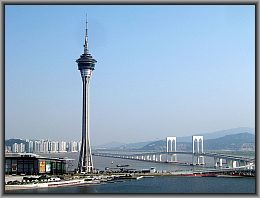
A-Ma Temple : Macau's name is derived from A-Ma-Gau or Place of A-Ma and this temple dedicated to the seafarers' goddess dates from the early 16th century. According to legend, A-Ma, a poor girl looking for passage to Canton, was refused by the wealthy junk owners but a lowly fisherman took her on board. A storm blew up and wrecked all but the boat carrying the girl. On arrival in Macau she vanished, to reappear as a goddess, on the spot where the fishermen built her temple. It consists of prayer halls, pavilions and courtyards built into the boulder-strewn hill and connected by winding paths through moon gates and tiny gardens. At the entrance is a large rock on which is engraved a traditional sailing junk. On other boulders are carved red characters invoking the gods or repeating a prayer. The festival of A-Ma takes place on the 23rd day of the 3rd moon (April or May). Firecrackers, to scare away evil spirits, are exploded in the entrance courtyard to greet tour groups and lions dances are performed here on weekends.
Guia Fortress : Guia Fortress, built in 1637-38, occupies the top of Guia Hill, the highest point in Macau. It was designed to defend Macau from attacks from the sea, but because of its position overlooking the entire city, its chief value has been as an observation post. It originally contained barracks, a water cistern, ammunition and equipment stores, the commander's house, and a chapel dedicated to Our Lady of Guia. Today the Fort's most prominent feature is the lighthouse, built in 1865 and the oldest on the China coast. It is 91 metres high and has a light which can be seen for around 20 miles in clear weather. Near the lighthouse is the chapel which contains an image of the Virgin Mary, a few antique pictures, and vestiges of paintings that date back to the construction of the chapel in 1626. Also nearby is a post where signals are hoisted to warn of an approaching typhoon. In earlier times storm warnings were announced from the bell-tower of the chapel.
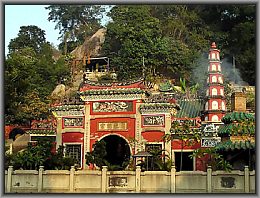
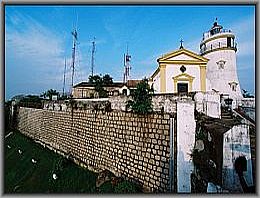
Senado Square : The Senado square is paved with a wave-patterned mosaic of colored stones, created by Portuguese experts. From the main road to the church of St. Dominic, the pavement extends to the ruins of St. Paul's, making the heart of the city a pedestrian paradise.
Senado Square and the Red Market Senado Square : Senado Square is the location of one of the newest municipal markets. On Avenida Almeida Ribeiro and the narrow streets leading off the main square you'll find a wealth of inexpensively priced goods of all kinds.
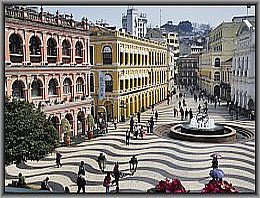
Taipa Sunday Fair - Taipa, Macau : A great place for a Sunday afternoon outing – Taipa Village Fair. Shopping here for souvenirs and gifts is great fun – anything from a cheong-sam bottle cover to a piece of jade or a delicate Chinese papercut design, you can even have your portraits sketched. The village main street too is full of shops selling clothes and souvenirs – local people call this street “Food Street” and you will soon see why. Apart from several restaurants there are lots of shops selling biscuits – Taipa has long been famous for biscuits – sheets of barbecued meats and nougat and sweets.
Arts and Crafts : There are several shops that carry handcrafted goods from China and other parts of Asia in Macau, and perhaps the best of these is located on Avenida Almeida Ribeiro near the Senado Square.
A tiny shop selling hand crafted traditional tea utensils, clothing, and musical instruments can be found on Rua de Hong Chau, near the Hyatt Regency on Taipa Island – it is worth a visit if only for its picturesque architecture and stone-lined rustic fountain.
Cakes and Sweets : Taipa Island is famous for its traditional cookies, and in the old village there are shops that have been baking and selling the same fragrant sweet morsels for generations. In Macau you may find pastry shops at the Av. Infante D. Henrique, Av. D. João IV , Travessa de S. Domingos, and along Rua de S. Paulo, near St. Paul's. Many other delectable confections found in local shops make good presents with the taste of Macau for visitors to take home with them. A famous Portuguese specialty in Macau is pastéis de nata, little egg tarts, which are sold at good cafes and bakeries in the city and Coloane. They are best when eaten warm from the oven.




